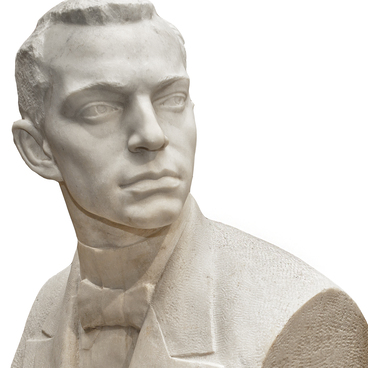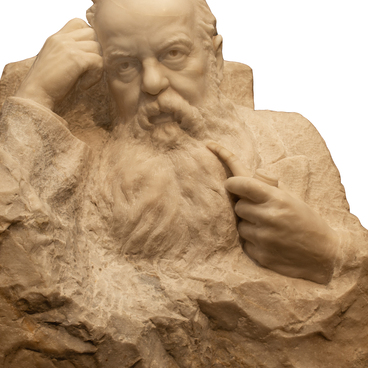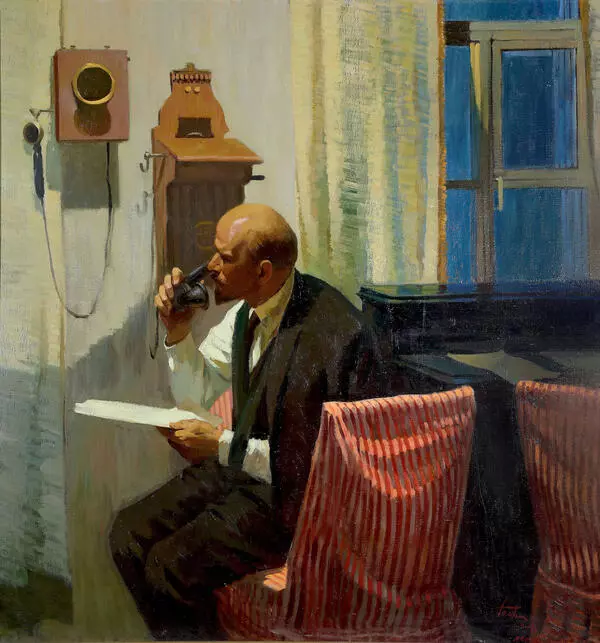This painting was created by a famous Ural portraitist Gennady Gayev. He depicted his daughter Ludmila, or Lusya, as he affectionately called her. The painter created a poetic image of a young woman deep in thought, standing half-turned against a neutral light gray background, which emphasizes her soft features and the richness of her hair color. The curls of her hair are arranged in the then-popular Babette style (a big bouffant on top of the head) and fixed with an orange hair clip.
Gayev decided on a minimalistic setting in order to draw the viewers’ attention to the model. Nevertheless, the painting still possesses interesting detail: in the upper right corner, there is a replica of Mikhail Vrubel’s “The Swan Princess”. It may seem that this inclusion is accidental, but in fact, it hints at the affection that Gayev felt towards his daughter. The image of Vrubel’s Swan Princess is often viewed as ‘an enchanting myth about the perfect beauty and its mysterious charm’.
The portrait was created in 1967 and reflected the tendencies of Soviet art of that time. By the end of the 1950s, the Soviet people were tired of the excessive enthusiasm of the main style, as well as of ubiquitous paintings glorifying the socialist ideas. That is why painters started to turn to the so-called ‘socialist realism with a human face’. The 1960s were distinct for the paintings with touching scenes about family values, which were close to people’s hearts. Such pictures often contained sentimental and moralistic concepts.
Gennady Gayev kept in tune with the new art trends. In the decades following the war, he was known in Sverdlovsk as a talented portraitist. There are a lot of great paintings in his extensive artwork that were commissioned, but the series of portraits of the Gayev family members deserves particular attention. Apart from the portrait of his daughter, the museum houses another significant painting — the portrait of Ilya Gayev, the painter’s son. Both works convey the feeling of special lyricism, warmth and tenderness.
Gayev decided on a minimalistic setting in order to draw the viewers’ attention to the model. Nevertheless, the painting still possesses interesting detail: in the upper right corner, there is a replica of Mikhail Vrubel’s “The Swan Princess”. It may seem that this inclusion is accidental, but in fact, it hints at the affection that Gayev felt towards his daughter. The image of Vrubel’s Swan Princess is often viewed as ‘an enchanting myth about the perfect beauty and its mysterious charm’.
The portrait was created in 1967 and reflected the tendencies of Soviet art of that time. By the end of the 1950s, the Soviet people were tired of the excessive enthusiasm of the main style, as well as of ubiquitous paintings glorifying the socialist ideas. That is why painters started to turn to the so-called ‘socialist realism with a human face’. The 1960s were distinct for the paintings with touching scenes about family values, which were close to people’s hearts. Such pictures often contained sentimental and moralistic concepts.
Gennady Gayev kept in tune with the new art trends. In the decades following the war, he was known in Sverdlovsk as a talented portraitist. There are a lot of great paintings in his extensive artwork that were commissioned, but the series of portraits of the Gayev family members deserves particular attention. Apart from the portrait of his daughter, the museum houses another significant painting — the portrait of Ilya Gayev, the painter’s son. Both works convey the feeling of special lyricism, warmth and tenderness.




